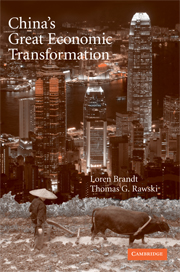Book contents
- Frontmatter
- Contents
- List of Figures
- List of Tables
- Contributors
- Acknowledgments
- Map
- 1 China's Great Economic Transformation
- 2 China and Development Economics
- 3 China in Light of the Performance of the Transition Economies
- 4 A Political Economy of China's Economic Transition
- 5 The Demographic Factor in China's Transition
- 6 The Chinese Labor Market in the Reform Era
- 7 Education in the Reform Era
- 8 Environmental Resources and Economic Growth
- 9 Science and Technology in China
- 10 The Political Economy of Private Sector Development in China
- 11 The Role of Law in China's Economic Development
- 12 China's Fiscal System: A Work in Progress
- 13 Agriculture in China's Development: Past Disappointments, Recent Successes, and Future Challenges
- 14 China's Financial System: Past, Present, and Future
- 15 China's Industrial Development
- 16 China's Embrace of Globalization
- 17 Growth and Structural Transformation in China
- 18 Income Inequality during China's Economic Transition
- 19 Spatial Dimensions of Chinese Economic Development
- 20 Forecasting China's Economic Growth to 2025
- Index
17 - Growth and Structural Transformation in China
Published online by Cambridge University Press: 24 May 2010
- Frontmatter
- Contents
- List of Figures
- List of Tables
- Contributors
- Acknowledgments
- Map
- 1 China's Great Economic Transformation
- 2 China and Development Economics
- 3 China in Light of the Performance of the Transition Economies
- 4 A Political Economy of China's Economic Transition
- 5 The Demographic Factor in China's Transition
- 6 The Chinese Labor Market in the Reform Era
- 7 Education in the Reform Era
- 8 Environmental Resources and Economic Growth
- 9 Science and Technology in China
- 10 The Political Economy of Private Sector Development in China
- 11 The Role of Law in China's Economic Development
- 12 China's Fiscal System: A Work in Progress
- 13 Agriculture in China's Development: Past Disappointments, Recent Successes, and Future Challenges
- 14 China's Financial System: Past, Present, and Future
- 15 China's Industrial Development
- 16 China's Embrace of Globalization
- 17 Growth and Structural Transformation in China
- 18 Income Inequality during China's Economic Transition
- 19 Spatial Dimensions of Chinese Economic Development
- 20 Forecasting China's Economic Growth to 2025
- Index
Summary
INTRODUCTION
Between 1978 and 2004 China's real GDP per capita grew at a rate of 8.16 percent per year. Some of this growth can be attributed to increases in labor force participation. On a per worker basis, GDP still increased at a real rate of 6.96 percent, implying a doubling of aggregate labor productivity every ten years and a quadrupling every twenty years. This impressive growth performance accompanied two important structural transformations.
The first, a fundamental feature of the economic development process, entailed large-scale reallocation of labor from agriculture to manufacturing and services, which pushed agriculture's share of total employment from 69 to 32 percent between 1978 and 2004. The second, unique to the transition process in former socialist economies, involves the reallocation of labor and other resources from state-owned enterprises (SOEs) to enterprises outside the state sector: over the same period, the state sector's share of nonagricultural employment fell from 52 percent to only 13 percent.
The primary objective of this chapter is to quantify the contributions of these two transformations and of productivity growth within each sector to China's overall growth and to systematically examine the forces driving each of these momentous changes. As will quickly become evident, this approach delivers a substantial payoff in the form of unexpected outcomes and a new perspective on the interaction among structural change, transition from socialism, and productivity growth during the course of China's long boom.
- Type
- Chapter
- Information
- China's Great Economic Transformation , pp. 683 - 728Publisher: Cambridge University PressPrint publication year: 2008
- 61
- Cited by



